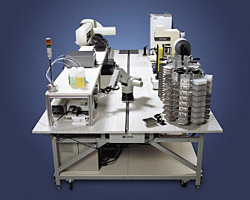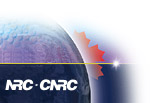Infrastructure
The GHI is a horizontal research program involving several NRC biotechnology institutes. Moreover, the GHI has established and makes use of shared infrastructure in the form of three core technology platforms. This section provides an overview of the NRC institutes and core technology platforms that are part of the GHI, as well as other NRC technology platforms and services accessed by GHI researchers. Participating NRC Institutes  | The NRC GHI has invested in core research technology platforms, as well as program specific infrastructure. This photo shows a robotic workstation which was developed as part of the Genome Sciences in Agricuture program at the Plant Biotechnology Institute. The workstation is an automated, high-throughput liquid handling center comprised of a series of liquid-handling devices integrated with a 4-meter robotic arm capable of analyzing 50,000 DNA samples in a 2-3 month period. |
GHI Infrastructure Platforms
The first phase of the GHI established three core infrastructure facilities High Throughput DNA Sequencing, Proteomics, and DNA MicroArray to support GHI Programs across the NRC. These facilities undertake research and client-oriented “service” activities utilizing state of the art technologies.
DNA microarray, or DNA chips are fabricated by high-speed robotics, generally on glass but sometimes on nylon substrates, for which probes with known identity are used to determine complementary binding, thus allowing massively parallel gene expression and gene discovery studies. An experiment with a single DNA chip can provide researchers information on thousands of genes simultaneously – a dramatic increase in throughput over older methods of observing gene expression. Read about the NRC microarray facility located in Montreal at the Biotechnology Research Institute.
DNA sequencing is the process of determining the exact order of chemical building blocks (called bases and abbreviated A, T, C, and G) making up the DNA of different organisms. Standard DNA sequencing methods are based on separating DNA fragments by gel electrophoresis, which is extremely labor intensive and expensive. New gel-based sequencers use multiple tiny (capillary) tubes to run standard electrophoretic separations. Through the GHI, the NRC has established a core DNA sequencing facility in Halifax at the Institute for Marine Biosciences.
Proteomics is the analysis of complete complements of proteins. Proteomics includes not only the identification and quantification of proteins, but also the determination of their localization, modifications, interactions, activities, and, ultimately, their function. Initially encompassing just two- dimensional (2D) gel electrophoresis for protein separation and identification, proteomics now refers to any procedure that characterizes large sets of proteins. The explosive growth of this field is being driven by multiple factors, including newly developed mass spectrometry approaches and innovative computational tools and methods to process, analyze, and interpret very large amounts of data. Through the GHI, the NRC has developed a major proteomics technology platform located in Ottawa at the Institute for Biological Sciences.
Experimental biology is increasingly dependent on the application of information science and technology. Bioinformatics, the interdisciplinary field at the intersection of life and information sciences, provides the necessary tools and resources for this endeavour. Computers have ceased to be merely useful tools in life sciences research, and have instead become essential tools for the extraction or knowledge from experimental data. Through the GHI, the NRC has invested in bioinformatics activities and formed a bioinformatics network. In addition, GHI researchers access the Canadian Bioinformatics Resource (CBR) which is based in Halifax at the Institute for Marine Biosciences. |



